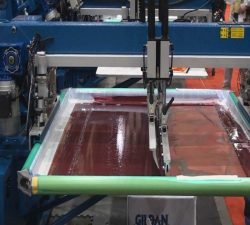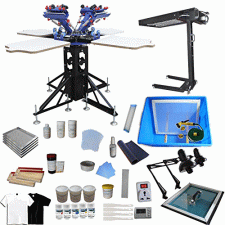Problems of Your Screen Printing Machine: typical screen printing issues
There are some typical screen printing issues you may face as a screen printer. If you are a screen printer, ensure that you address these issues so they don’t affect your productivity and business.
Maintaining color density is difficult in halftone printing. That is because the proportional densities of the four process colors determine hues in this process. Several factors can disrupt these proportions by determining the amount of ink flowing through a particular screen.
The most common cause is a varying level of plates, which results in a change in the critical off-contact distance and leads to a visible shift.
Screen printing is one of the easiest printing methods. Operating a screen printing machine requires minimal technical knowledge, but some practical experience is also necessary. Sometimes, printing quality may vary for many reasons. Every component of a screen printing machine has a significant impact on printing quality.
Therefore, any issue with any part of the printing materials significantly impacts the job’s outcome. For all these reasons, if any situation, even a minor one, arises, addressing it as early as possible is very important. If you have screen printing machines or a screen-printing business, it is essential to have a thorough understanding of the issues that may arise with your screen printing machines.

Adjusting the Screen Tension
The performance of a screen printing machine deteriorates with loose screens. Suppose the screens of your screen printing equipment become loose; to tighten them, enlist the help of an efficient person. Screens in tight conditions perform well. It is crucial to ensure that all screens perform simultaneously for a particular print function. The dissimilarity of screen tension causes the registration problem.
So, check again and again to resolve this issue. Adjust the screen tension to maintain an equal tension level if any discrepancy is found. It ensures better output with minimal fluctuation in quality.

Penetration of Ink into the Shirt
This generally happens due to excessive pressure applied to the screen. The ink may be too thin, the squeegee may be too hard, or the fabric’s weave may be excessively open, allowing for this penetration. Check the pressure of the squeegee before every action. It’s advisable to set it at a minimum level. For added assurance, conduct some trial operations to observe the ink condition on the garment’s underside.
Solving the Problem of Over-Flashing
This problem is that the ink dries on the screen. For this problem, the screen mesh’s open parts get clogged. Due to excessive heat during the printing process, this problem occurs. The issue of overheating can be solved by using proper off-contact. After the squeegee passes over the garment, the screen peels away from the print, thus maintaining minimal contact with the heated print.
Dye Migration
It is the process of converting the white print into a colored one. Typically, this occurs on polyester or garments containing a polyester blend. Polyester garment dye gets released at a high curing temperature of the screen printer’s ink. Dye migration may occur this way- white ink turns pink on red fabric and gray on black fabric.
Therefore, avoid garments made from camouflage fabrics that are prone to excessive dye migration. Ink selection is also crucial in preventing dye migration. Low-bleed, low-cure under-base inks should be used. If you have no option but to change the garment prone to bleeding, it is wise to use special gray or black blocking ink designed to absorb the dye.
Sudden Movement of the Garment During Screen Printing
If you start printing with a screen printing press and the garment on which you are printing starts to move midway through the printing process, the entire operation is seriously affected. It isn’t enjoyable. It is advisable to use special industrial adhesives that resist the unwanted movement of the garment. Some types of adhesives, particularly water-based ones, are very suitable for use. They are less affected by the heat of the printing unit than other types.

Solving the Ink Deposition Issue
This issue significantly hampers the printing quality. For manual screen printing, it is advisable to flood the screen before each print, as this pushes the ink into the printed area. Automatic screen printers do the flooding of the screen before each printing. If screens are not flooded, it will require applying excess pressure on the print stroke. Causes the ink to penetrate the fabric. Therefore, the ultimate result will be the loss of money, ink, and time.
Another trick for avoiding ink deposition is maintaining a sharp squeegee edge. It ensures a smooth release. The irregular edge of the squeegee significantly affects its performance. Use soft or squeegees whenever required, depending on your requirement. You can save the ink by adjusting the angle of the squeegee. Maintain consistent pressure to facilitate troubleshooting during a running printing operation.
Problem with Emulsion
Ensuring emulsion quality is another crucial issue in screen printing. Notice whether the bottom of the screen’s shirt side contains a thicker emulsion deposit. If not, confirm it. Different emulsions hold the ink during the pressure, acting as a gasket and resisting the movement of ink. If ink moves unintentionally, uneven edges may result.
The emulsion of thick type ensures a higher level of opacity. In the absence of enough emulsion on the bottom of the screen during printing of fine details, distortion of the dots may happen. So, it is essential to ensure the quality and proper thickness of the emulsion to achieve the desired quality with the screen printing machine.
What to do with the cured Prints?
Curing the ink is critical. Poor or improper curing may result in a disturbing quality of printing. The entire layer of ink needed to heal at the prescribed temperature for a sufficient period. Without maintaining time correctly, it is not possible to ensure adequate curing. It is wise to run the screen through a dryer for one minute at an appropriate temperature, which may ease the issue extensively.
So, we may conclude that the problems with a screen printing machine are not very complicated. The issues, as well as any unique or costly mechanisms, are not required. Some simple tricks or awareness may solve the entire problem without spending money. However, it is essential to understand the issues and identify the sources of a problem.
Check out:
10 Best Heat Press Machine Reviews
7 Best T-shirt Printing Machine Reviews

Leave a Reply
You must be logged in to post a comment.